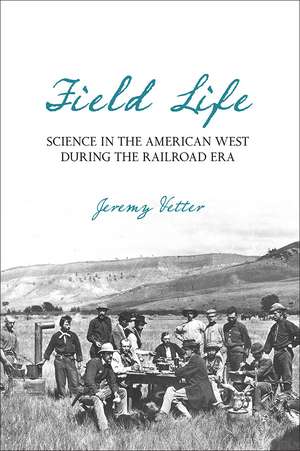Field Life: Science in the American West during the Railroad Era: INTERSECTIONS: Histories of Environment
Autor Jeremy Vetteren Limba Engleză Hardback – 25 noi 2016
Winner, 2018 HSA Phillip J. Pauly Prize
Field Life examines the practice of science in the field in the Great Plains and Rocky Mountains of the American West between the 1860s and the 1910s, when the railroad was the dominant form of long-distance transportation. Grounded in approaches from environmental history and the history of technology, it emphasizes the material basis of scientific fieldwork, joining together the human labor that produced knowledge with the natural world in which those practices were embedded.
Four distinct modes of field practice, which were shared by different field science disciplines, proliferated during this period—surveys, lay networks, quarries, and stations—and this book explores the dynamics that underpinned each of them. Using two diverse case studies to animate each mode of practice, as well as the making of the field as a place for science, Field Life combines textured analysis of specific examples of field science on the ground with wider discussion of the commonalities in the practices of a diverse array of field sciences, including the earth and physical sciences, the life and agricultural sciences, and the human sciences.
By situating science in its regional environmental context, Field Life analyzes the intersection between the cosmopolitan knowledge of science and the experiential knowledge of people living in the field. Examples of field science in the Plains and Rockies range widely: geological surveys and weather observing networks, quarries to uncover dinosaur fossils and archaeological remains, and branch agricultural experiment stations and mountain biological field stations.
Field Life examines the practice of science in the field in the Great Plains and Rocky Mountains of the American West between the 1860s and the 1910s, when the railroad was the dominant form of long-distance transportation. Grounded in approaches from environmental history and the history of technology, it emphasizes the material basis of scientific fieldwork, joining together the human labor that produced knowledge with the natural world in which those practices were embedded.
Four distinct modes of field practice, which were shared by different field science disciplines, proliferated during this period—surveys, lay networks, quarries, and stations—and this book explores the dynamics that underpinned each of them. Using two diverse case studies to animate each mode of practice, as well as the making of the field as a place for science, Field Life combines textured analysis of specific examples of field science on the ground with wider discussion of the commonalities in the practices of a diverse array of field sciences, including the earth and physical sciences, the life and agricultural sciences, and the human sciences.
By situating science in its regional environmental context, Field Life analyzes the intersection between the cosmopolitan knowledge of science and the experiential knowledge of people living in the field. Examples of field science in the Plains and Rockies range widely: geological surveys and weather observing networks, quarries to uncover dinosaur fossils and archaeological remains, and branch agricultural experiment stations and mountain biological field stations.
Preț: 457.24 lei
Preț vechi: 537.94 lei
-15% Nou
Puncte Express: 686
Preț estimativ în valută:
87.50€ • 93.56$ • 72.95£
87.50€ • 93.56$ • 72.95£
Carte disponibilă
Livrare economică 27 martie-10 aprilie
Preluare comenzi: 021 569.72.76
Specificații
ISBN-13: 9780822944539
ISBN-10: 0822944537
Pagini: 512
Ilustrații: 23 b&w illustrations
Dimensiuni: 152 x 229 x 41 mm
Greutate: 0.82 kg
Ediția:1
Editura: University of Pittsburgh Press
Colecția University of Pittsburgh Press
Seria INTERSECTIONS: Histories of Environment
ISBN-10: 0822944537
Pagini: 512
Ilustrații: 23 b&w illustrations
Dimensiuni: 152 x 229 x 41 mm
Greutate: 0.82 kg
Ediția:1
Editura: University of Pittsburgh Press
Colecția University of Pittsburgh Press
Seria INTERSECTIONS: Histories of Environment
Recenzii
“Vetter's extensive research makes Field Life useful for exploring the development of the fledgling sciences in the American West.”
—Kansas History
—Kansas History
"Vetter brings the history of science into dialogue with the history of technology, labor history, and environmental history, producing a densely researched and richly textured account of "science in action" on the Great Plains and in the Rocky Mountains."
—H-Net Reviews
—H-Net Reviews
Historian Jeremy Vetter has produced a remarkable study of scientific exploration in the late nineteenth and early twentieth centuries.
—Nebraska History
"Field life is a veritable goldmine of interesting data and critical analysis."
—Archives of Natural History
—Archives of Natural History
"Field Life is a terrific book, sumptuously illustrated, that will be of great interest to historians of science, environmental historians, and historical geographers alike."
—Isis
—Isis
Notă biografică
Jeremy Vetter is associate professor of history at the University of Arizona.
Descriere
Field Life examines the practice of science in the field in the Great Plains and Rocky Mountains of the American West between the 1860s and the 1910s, when the railroad was the dominant form of long-distance transportation. Grounded in approaches from environmental history and the history of technology, it emphasizes the material basis of scientific fieldwork, joining together the human labor that produced knowledge with the natural world in which those practices were embedded.










































